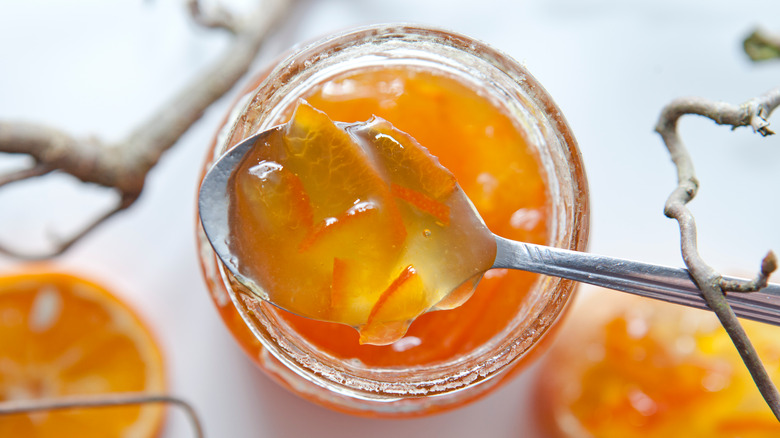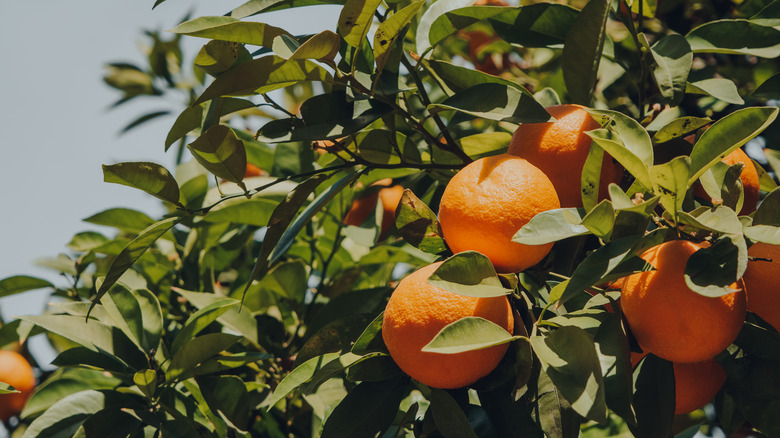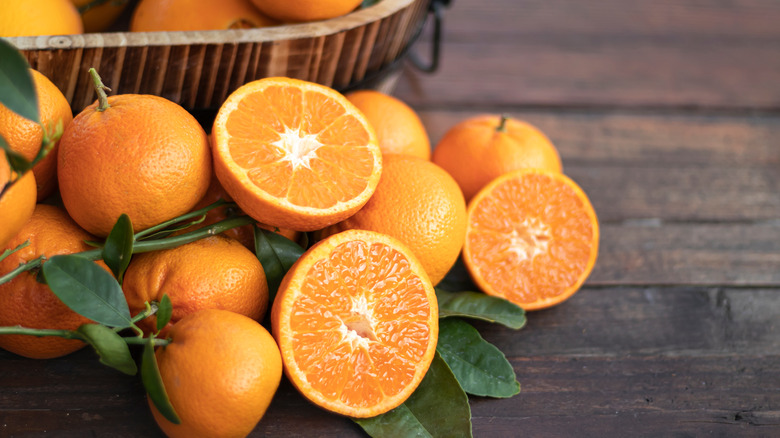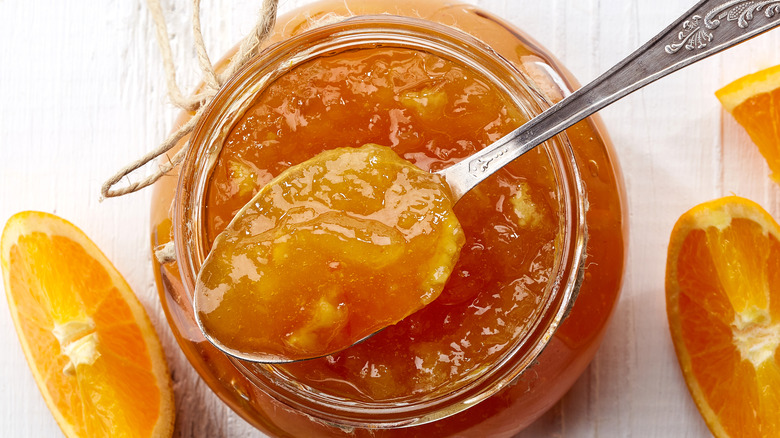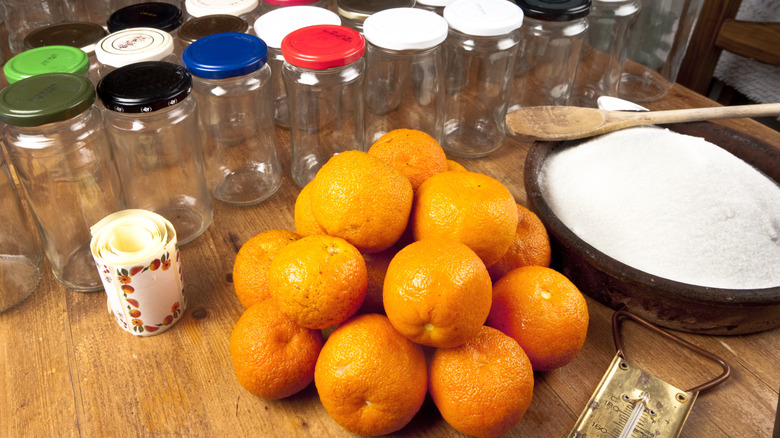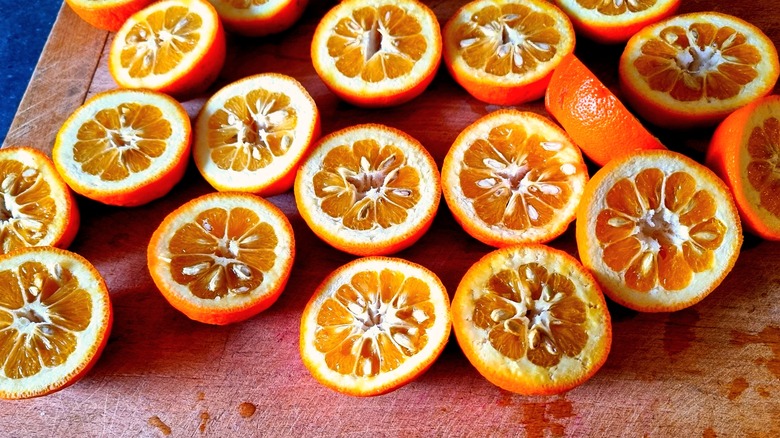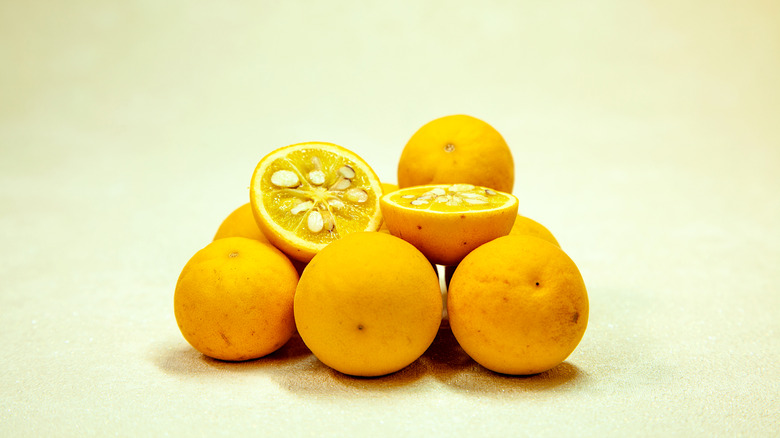The Unique Type Of Orange Used For British Marmalades
You might be a fan of oranges, but we're guessing you might have never consumed oranges like these before. Seville oranges — also known as "bitter oranges" — aren't enjoyed in the same way other citrus fruits are, because while the fruit itself cannot be eaten, its rind, juice, and zest are used as a primary ingredient not just to make preserves with, but to dress salads and seafood dishes too. It is used in place of lemon juice, and as the BBC points out, it takes the lead as a star ingredient for both sauces and desserts.
The fruit may be part of Europe's culinary landscape today, but it wasn't originally native to the region. The oranges were first grown in Asia before they were introduced into Spain courtesy of the Moors who brought them to the region more than a thousand years ago. Likely because of the way its fruits tasted, the orange trees were primarily used as decorative plants. Today, Seville has more than 40,000 orange trees, and the city has become known as the first in the world with the biggest number of orange trees to occupy urban space.
But you won't find anyone fighting to consume these oranges. An estimated 12.5 million pounds of this fruit fall to the ground every winter where they are squashed (and have become a seasonal problem for the city's government).
What Seville oranges are
Seville oranges — Citrus aurantium L., scientifically speaking — are the progeny of an orange and a pomelo. These types of oranges are not very big — they come in between two and a half to three inches in size. Unlike some oranges that can have a smooth rind, Seville oranges have a rough and bumpy peel, and a thick, white, spongy pith. And while they might look like just about any orange out there, the Seville orange peels are said to contain a high level of essential oil that is described as floral with a slightly bitter note.
The residents of the Spanish town aren't exactly in love with the fruit that adopted the city's name — likely because its segments aren't very tasty when they are consumed fresh. As one native told Mapping Spain, "Those [kinds] of oranges are not good to eat, they're very bitter and not meant for humans." That explains why so much fruit is wasted every year. For what it's worth, the juice of the Seville orange can be used in cooking. On the whole, the most famous way Seville oranges are used is as the primary ingredient for British orange marmalade.
Bitter oranges vs sweet oranges
While Seville oranges can also be known as "bitter oranges", they aren't the only citrus fruit that fits this flavor profile. These types of oranges, which include the Bergamot orange, are prized not for their flesh which is usually dry and bitter. Instead, they are cultivated for their peel, which is more fragrant than their sweet counterparts. Their peels are usually thicker than those found on sweet oranges — and they pack a load of essential oils. They are also high in pectin — hence, why you don't need to add it yourself — making them the best ingredient for preserves like marmalade.
By contrast, sweet oranges — Citrus sinensis, for science nerds — are generally eaten fresh as a dessert or snack. Its peel is different from its bitter cousin because it is smooth and thin, making it easy to remove. Because its rind isn't bitter, the peel can be used to make light desserts including soufflés, mousses, as well as frozen treats. Sweet oranges are also popular in the U.S. because they are used to make concentrated orange juice. Varieties of sweet orange include Cara Cara, Fukumoto, and Spring.
What Seville oranges taste like
Seville oranges aren't just known as "bitter oranges" for nothing. Not only are they true to their name, but they are also sour to boot. Writing in The Guardian, British food writer and Seville orange fan Bee Wilson described their flavor as "lemons with the sharp edges rounded off."
In spite of their sharp flavor qualities — which make them un-sweet-orange-like and questionable to Seville's locals as a result — these bitter oranges are sought after in Britain, where the intense orange flavor that comes with their bitter/sour tasting notes is the foundation for classic British marmalade. Its orange note is so distinctive in fact, BBC notes that it's the reason Cointreau and Grand Marnier came to be. The outside world's embrace of Seville's oranges and their sharp flavor explains why a majority of the estimated 15 thousand tonnes of Seville oranges that are produced annually end up outside Spain.
How to cook with Seville oranges
British marmalade makers prize Seville oranges not just because they have a strong orange flavor that outdoes any other sweet orange, but also because the fruit itself is very rich in naturally occurring pectin which is needed to make a good marmalade.
To remove the rind properly, BBC suggests first washing the fruit in warm water and then using a peeler to separate the rind from the rest of the fruit, taking care not to remove the white part known as the pith because it is very bitter. If you want to extract its juices, you'll then want to soak the fruit in boiling water for five minutes, before straining the juice properly to remove all the seeds.
Though the juice is also bitter, it can be used in place of lemons to dress up savory foods like seafood. Diversivore suggests using the juice in sauces for pork, duck, and rich meats. The flavor of Seville oranges is reminiscent of the intense orange flavors found in Cuban and Mexican cooking.
If you want to attempt to replicate the flavor of a Seville orange, you can try mixing sweet orange and lemon juice in a 1:1 ratio or use a mix of grapefruit, orange, and lime in a 1:1:1 ratio.
The nutritional profile of a Seville orange
While the Seville orange is hardly consumed as a fruit, one look at its nutritional profile makes us wish we could eat it fresh. Seville oranges contain P-synephrine, which can cause weight loss when consumed in large amounts. But studies have shown that the fruit doesn't affect the human body the way other extracts might. Other than P-synephrine, Seville oranges also contain limonene, which can be used as an antiviral and anti-inflammatory.
On the alternative medicine front, the fruit has a record of having been used in traditional Chinese medicine to deal with gut disorders that include indigestion, constipation, and diarrhea.
While all oranges are assumed to have high levels of vitamin C, bitter orange is seen to have more quantities of this vitamin than many varieties. A small Seville orange can have up to 90 milligrams per fruit. Aside from this, bitter orange is known to have vitamin A, as well as calcium and iron.
If you were to attempt to eat a Seville orange, you'd be rewarded with 66 calories per fruit, trace amounts of fat, and up to 15.2 grams of carbs.
Other types of bitter oranges
The Seville orange may hold a prominent place in British culture, thanks to its important role in the making of marmalade, but it's not the only bitter orange variety out there. There is also the bergamot orange, whose roots (literally) are in Italy, and which is usually used in scents and to flavor Earl Grey tea. Bergamot oranges stand out because they aren't orange but green in color. Like its cousin the Seville orange, bergamot oranges are acidic and bitter.
Another bitter orange that is used exclusively to make marmalades is the trifoliate orange, or the Poncirus trifoliata, which is native to Korea and China. Their juices cannot be used at all because of the fruit's strong bitter taste. But its peel is popular not just for making marmalade, it is also used to make a powdered condiment. As an added bonus, the trifoliate orange is used in Eastern medicine to treat allergic inflammation, per Phytognosis.
